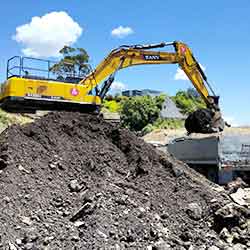Soil Contamination and Asbestos
When asbestos is present in your home or business’s building materials, you might think that is only where the problem lies. Once you remove the building materials, you’ve removed the asbestos, right? Not always.
Soil contamination caused by asbestos is a genuine concern, and it happens more often than you think. Not sure what happens when soil is contaminated, or what you can do next? Read on to find out.
What Causes Soil Contamination?
Many things can lead to soil contamination caused by asbestos. It might exist as a friable form of asbestos in pipe lagging, or it could even be asbestos waste that has been illegally dumped. As most people know, all asbestos waste has to be dumped at an authorised asbestos waste removal site.
Sometimes, soil can also become contaminated from bonded asbestos forms that have become friable or building materials deteriorating over time, leaching into the ground. Even stumps of asbestos fencing can lead to asbestos in soil. Whatever the cause, determining its danger and forming a plan of action can be essential.
What Happens When Soil Is Contaminated?
If you have reason to believe that soil around your home or business is contaminated, then confirming it is crucial. Fortunately, the process is as simple as ordering an asbestos soil sample or test.
These tests can confirm many things, such as:
The asbestos type
How it is formed
The condition of the asbestos-contaminated materials
The location of the asbestos
How deep it can be traced
The presence or absence of visible asbestos soil contamination
There is also a little bit of mathematics involved in the process, with a calculation to estimate how much asbestos contamination exists.
% soil asbestos =
% asbestos content x ACM (KG) / soil volume (L) x soil density (kg/L)
You don’t have to be a mathematician to work this out. Your chosen asbestos removal company can handle everything for you.
Is Soil Contamination a Problem?
Yes, soil contamination can be a problem – in the same way that asbestos building products in and around your home can be. Asbestos can’t break down, which means if it’s present in the soil now, it will be present in the soil likely forever without actions being taken to remove it.
What’s more, if the ground in which the asbestos lies is dry, there’s a genuine risk of those asbestos fibres becoming airborne once you disturb the soil. You can keep the site damp with water sprinkling and misting to prevent these fibres from drying out, but this is not a long-term solution. Rather, it’s a short-term measure until you hire an asbestos removal company to help.
Asbestos in a landfill
On the upside, even if asbestos has contaminated your soil, it won’t poison the soil or affect your groundwater. It’s only when people aren’t aware of its presence and dig up or agitate the earth that it becomes an issue.
How Do You Fix Contaminated Soil?
Whether you’re undertaking groundworks or have identified asbestos after a soil test, you now have to focus on how to fix contaminated soil.
The soil test would have determined everything an asbestos removal company needs to know so that they can carry out a safe and effective soil removal process. Only a class A licensed asbestos removalist can remove the soil, which may involve the use of machinery and equipment, such as a disposal vehicle and excavator.
Once the machines have removed the soil down to the depth it has been identified, they must keep it damp before packaging it for transport. By doing so, they can prevent dust and fibres from becoming airborne.
Soil is then transferred to suitable containers before being sealed and labelled as “asbestos-containing”. Licensed removalists can then take it to an approved waste removal site, where no one can accidentally stumble upon it and put themselves at risk.
Why Hire the Experts for Contaminated Soil Removal?
As a nation of DIYers, it’s only natural for us to want to get stuck in and remove what we think could be asbestos-contaminated soil. However, given how dangerous friable asbestos can be, it’s in your best interests to leave this task up to the experts.
After carrying out soil testing, they can put together a plan of attack that outlines how deep they must dig to remove the contaminants. If you have not carried out soil sampling and only assume asbestos is present, your soil removal may not be enough to take care of the problem.
You may also not use the most appropriate PPE for the job or have a safety plan in place for keeping yourself and those around you safe.
As a result, if you plan to disturb your soil or already have and believe asbestos is present, contact an asbestos removal specialist to take over the management and removal process.


